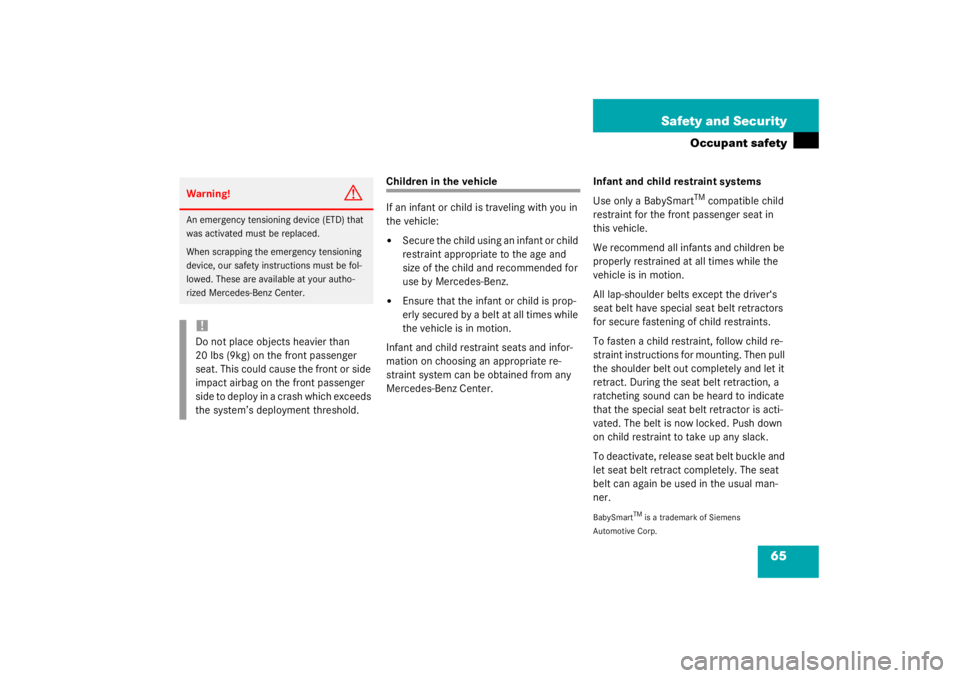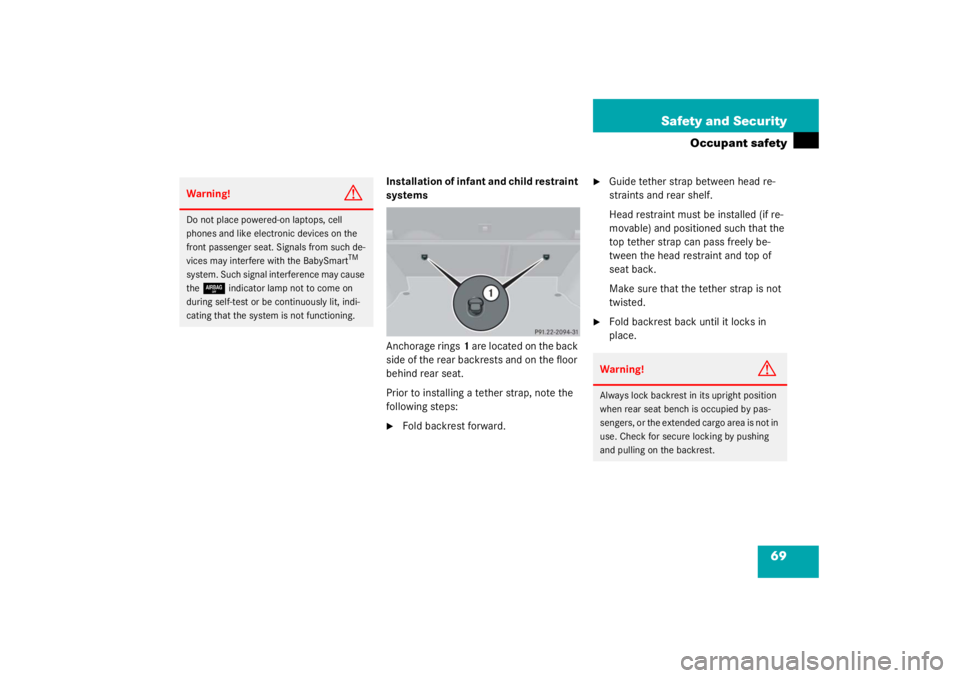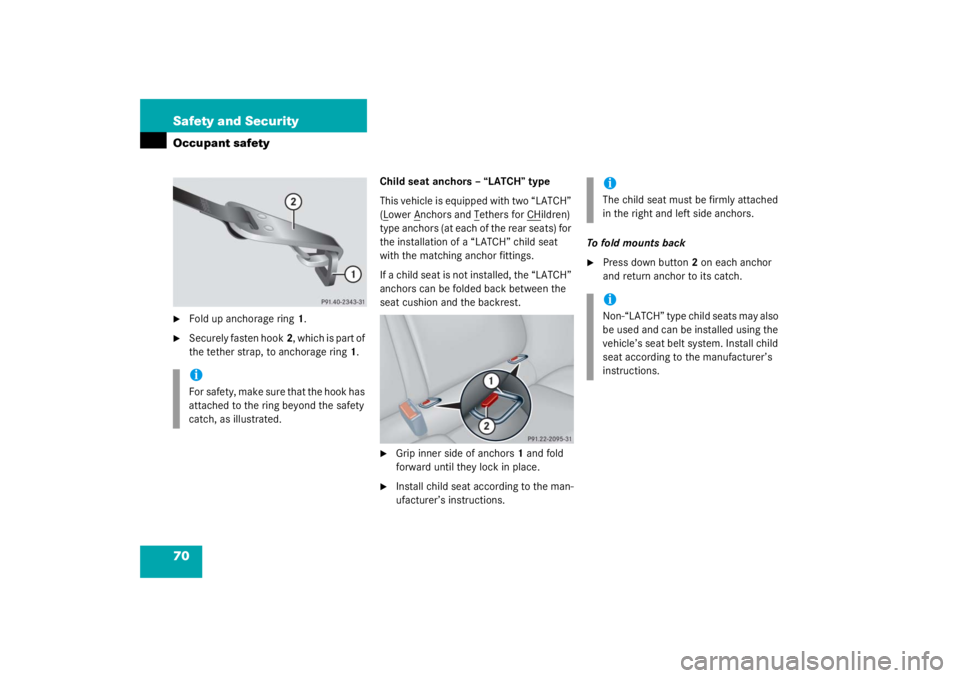Page 49 of 356

49
Getting started
Driving
Single wipe�
Press switch briefly in the direction of
arrow
1.
The windshield wipers wipe one time
without washer fluid.
Wiping with windshield washer fluid
�
Push switch in the direction of arrow 1
past the resistance point.
The windshield wiper operates with
washer fluid.
iVehicles without rain sensor*: Fast
wiper speed III goes to setting II when
the vehicle is standing still.
Vehicles with rain sensor*: Intermittent
wiping interval dependent on wetness
of windshield. Wiping will not occur
with a door open.!Vehicles with rain sensor*: Do not
leave in intermittent setting when vehi-
cle is taken to an automatic car wash or
during windshield cleaning. Wipers will
operate in presence of water sprayed
on the windshield, and wipers may be
damaged as a result.
The switch should not be left in inter-
mittent setting as the wipers will wipe
the windshield once every time the en-
gine is started. Dust that accumulates
on the windshield might scratch the
glass when wiping occurs on a dry
windshield.
!If leaves, snow, etc. block the wind-
shield wipers, switch off the wipers.�
For safety reasons, withdraw key
from starter switch. Remove block-
age.
�
Turn the windshield wipers on
again.
If windshield wipers fail to function at
all in switch position I,
�
set the combination switch to the
next highest wiper speed.
�
have the windshield wipers
checked at the nearest authorized
Mercedes-Benz Center.
Page 51 of 356

51
Getting started
Parking and locking
Parking and locking
You have now completed your first drive.
You have properly stopped and parked
your vehicle. End your drive as follows.
Parking brake
1 Release handle
2 Parking brake�
Step firmly on parking brake 2.
When the engine is running, the indica-
tor lamp
;
(USA only) or
3
(Canada only) in the instrument cluster
will be illuminated.
Warning!
G
Wait until the vehicle is stationary before re-
moving the key from the starter switch. The
vehicle cannot be steered when the key is
removed.Warning!
G
With the engine not running, there is no
power assistance for the brake and steering
system. In this case, it is important to keep
in mind that a considerably higher degree of
effort is necessary to stop or steer the vehi-
cle.
Warning!
G
Do not park this vehicle in areas where com-
bustible materials such as grass, hay or
leaves can come into contact with the hot
exhaust system, as these materials could be
ignited and cause a vehicle fire.
To reduce the risk of personal injury as a re-
sult of vehicle movement, before turning off
the engine and leaving the vehicle always:�
Keep right foot on brake pedal.
�
Firmly depress parking brake pedal.
�
Move the selector lever to position P
(manual transmission: first or reverse
gear).
�
Slowly release brake pedal.
�
When parked on an incline, turn front
wheels towards road curb.
�
Turn the key to starter switch position 0
and remove.
�
Take the key and lock vehicle when leav-
ing.
Page 52 of 356

52 Getting startedParking and locking
Switching off headlamps�
Turn the exterior lamp switch to
M
(
�page 47).
More information can be found in the
“Controls in detail” section (
�page 96).
Turning off engine �
Place the gear selector lever in
position P (manual transmission: first
or reverse gear).
Warning!
G
When leaving the vehicle, always remove the
key from the starter switch and lock the ve-
hicle. Do not leave children unattended in
the vehicle, or with access to an unlocked
vehicle. Children could release the parking
brake and/or move the gear selector lever
from position P, either of which could result
in an accident and/or serious injury.
Warning!
G
Getting out of your vehicle with the selector
lever not fully engaged in position P is dan-
gerous. Also, when parked on an incline,
position P alone may not prevent your vehi-
cle from moving, possibly hitting people or
objects.
Always set the parking brake in addition to
shifting to position P (manual transmission:
first or reverse gear).
When parked on an incline, turn front wheels
towards the road curb.
iAlways set the parking brake in addi-
tion to shifting to position P (manual
transmission: first or reverse gear). iOn steep slopes, turn the front wheels
towards the road curb.
Page 53 of 356
53
Getting started
Parking and locking
Turning off with the SmartKey�
Turn the key in the starter switch to
position
0 and remove it.
The immobilizer is activated.
�
Press the seat belt release button
(�page 41).
�
After exiting the vehicle press the lock
button
‹
on the remote control
(
�page 30).
The locking knobs on the doors move
down.
More information can be found in the
“Controls in detail” section (
�page 82).
iVehicles with automatic transmission:
The SmartKey can only be removed
from the starter switch with the gear
selector lever in position P.!With the SmartKey removed and the
driver’s door open, a warning sounds if
the vehicle’s exterior lamps are not
switched off.
Warning!
G
To prevent possible personal injury, always
keep hands and fingers away from the door
openings when closing the doors. Be espe-
cially careful when small children are
around.
Before closing doors, make sure that there
is no possibility of someone getting caught
in a door during closing.
Page 65 of 356

65
Safety and Security
Occupant safety
Children in the vehicle
If an infant or child is traveling with you in
the vehicle:�
Secure the child using an infant or child
restraint appropriate to the age and
size of the child and recommended for
use by Mercedes-Benz.
�
Ensure that the infant or child is prop-
erly secured by a belt at all times while
the vehicle is in motion.
Infant and child restraint seats and infor-
mation on choosing an appropriate re-
straint system can be obtained from any
Mercedes-Benz Center. Infant and child restraint systems
Use only a BabySmart
TM compatible child
restraint for the front passenger seat in
this vehicle.
We recommend all infants and children be
properly restrained at all times while the
vehicle is in motion.
All lap-shoulder belts except the driver‘s
seat belt have special seat belt retractors
for secure fastening of child restraints.
To fasten a child restraint, follow child re-
straint instructions for mounting. Then pull
the shoulder belt out completely and let it
retract. During the seat belt retraction, a
ratcheting sound can be heard to indicate
that the special seat belt retractor is acti-
vated. The belt is now locked. Push down
on child restraint to take up any slack.
To deactivate, release seat belt buckle and
let seat belt retract completely. The seat
belt can again be used in the usual man-
ner.
BabySmart
TM is a trademark of Siemens
Automotive Corp.
Warning!
G
An emergency tensioning device (ETD) that
was activated must be replaced.
When scrapping the emergency tensioning
device, our safety instructions must be fol-
lowed. These are available at your autho-
rized Mercedes-Benz Center.!Do not place objects heavier than
20 lbs (9kg) on the front passenger
seat. This could cause the front or side
impact airbag on the front passenger
side to deploy in a crash which exceeds
the system’s deployment threshold.
Page 69 of 356

69
Safety and Security
Occupant safety
Installation of infant and child restraint
systems
Anchorage rings
1 are located on the back
side of the rear backrests and on the floor
behind rear seat.
Prior to installing a tether strap, note the
following steps:�
Fold backrest forward.
�
Guide tether strap between head re-
straints and rear shelf.
Head restraint must be installed (if re-
movable) and positioned such that the
top tether strap can pass freely be-
tween the head restraint and top of
seat back.
Make sure that the tether strap is not
twisted.
�
Fold backrest back until it locks in
place.
Warning!
G
Do not place powered-on laptops, cell
phones and like electronic devices on the
front passenger seat. Signals from such de-
vices may interfere with the BabySmart
TM
system. Such signal interference may cause
the
7
indicator lamp not to come on
during self-test or be continuously lit, indi-
cating that the system is not functioning.
Warning!
G
Always lock backrest in its upright position
when rear seat bench is occupied by pas-
sengers, or the extended cargo area is not in
use. Check for secure locking by pushing
and pulling on the backrest.
Page 70 of 356

70 Safety and SecurityOccupant safety�
Fold up anchorage ring1.
�
Securely fasten hook 2, which is part of
the tether strap, to anchorage ring 1. Child seat anchors – “LATCH” type
This vehicle is equipped with two “LATCH”
(L
ower A
nchors and T
ethers for CH
ildren)
type anchors (at each of the rear seats) for
the installation of a “LATCH” child seat
with the matching anchor fittings.
If a child seat is not installed, the “LATCH”
anchors can be folded back between the
seat cushion and the backrest.
�
Grip inner side of anchors 1 and fold
forward until they lock in place.
�
Install child seat according to the man-
ufacturer’s instructions. To fold mounts back
�
Press down button
2 on each anchor
and return anchor to its catch.
iFor safety, make sure that the hook has
attached to the ring beyond the safety
catch, as illustrated.
iThe child seat must be firmly attached
in the right and left side anchors.iNon-“LATCH” type child seats may also
be used and can be installed using the
vehicle’s seat belt system. Install child
seat according to the manufacturer’s
instructions.
Page 71 of 356
71
Safety and Security
Occupant safety
Warning!
G
Children too big for child restraint systems
must ride in back seats using regular seat
belts. Position shoulder belt across chest
and shoulder, not face or neck.
A booster seat may be necessary to achieve
proper belt positioning for children from
41 lbs. until they reach a height where a
lap/shoulder belt fits properly without a
booster.
Before installing the child seat, make sure
anchors
1 are folded out and locked in
place.
Install child seat according to manufactur-
er’s instructions.
T h e c h i l d s e a t m u s t b e f i r m l y a t t a c h e d i n t h e
right and left side anchors 1.
An incorrectly mounted child seat may come
loose during an accident which could result
in serious injury or death to your child.
Damaged or impact-damaged child seats or
child seat anchors must be replaced.
Do not leave children unattended in the ve-
hicle, even if the children are secured in a
child restraint system.